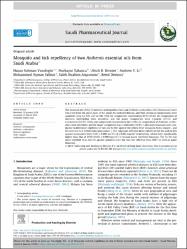| dc.contributor.author | Yusufoğlu, Hasan Soliman | |
| dc.contributor.author | Tabanca, Nurhayat | |
| dc.contributor.author | Bernier, Ulrich R. | |
| dc.contributor.author | Li, Andrew Y. | |
| dc.contributor.author | Salkini, Mohammed Ayman | |
| dc.contributor.author | Alqasoumi, Saleh İbrahim | |
| dc.contributor.author | Demirci, Betül | |
| dc.date.accessioned | 2019-10-19T14:15:15Z | |
| dc.date.available | 2019-10-19T14:15:15Z | |
| dc.date.issued | 2018 | |
| dc.identifier.issn | 1319-0164 | |
| dc.identifier.issn | 2213-7475 | |
| dc.identifier.uri | https://dx.doi.org/10.1016/j.jsps.2018.03.012 | |
| dc.identifier.uri | https://hdl.handle.net/11421/12716 | |
| dc.description | WOS: 000444004000016 | en_US |
| dc.description | PubMed ID: 30202228 | en_US |
| dc.description.abstract | The essential oils (EOs) of Anthemis melampodina (Am) and Anthemis scrobicularis (As) (Asteraceae) were extracted from the aerial parts of the plants by hydrodistillation, and their chemical compositions were analyzed using GC-FID and GC-MS. Fifty-six components representing 85.5% of the oil composition of Anthemis melampdina were identified, and the major components were cx-pinene (17.1%) and beta-eudesmol (13.8%). Forty-one components representing 86% of the oil composition of Anthemis scrobicularis were identified, and the major component was beta-eudesmol (12.8%). Laboratory bioassays were conducted to determine repellency of Am and As EOs against the yellow fever mosquito Aedes aegypti L. and the lone star tick Amblyomma americanum L. The minimum effective doses (MEDs) of the Am and As EOs against mosquitoes were 0.187 +/- 0.000 and 0.312 +/- 0.063 mg/cm(2) respectively, which were significantly higher than that of DEET (0.023 +/- 0.000 mg/cm(2)) in human-based repellent bioassays. The As EO was more repellent than Am EO against nymphal ticks but was less effective than DEET in vertical paper bioassays | en_US |
| dc.description.sponsorship | U.S. Department of Defense - United States through the Armed Forces Pest Management Board | en_US |
| dc.description.sponsorship | This study was in part funded by a Deployed War-Fighter Protection Research Program Grant by the U.S. Department of Defense - United States through the Armed Forces Pest Management Board. We thank Natasha M. Agramonte, Greg Allen, Ingeborg Cuba and Erin O'Reilly (USDA, ARS, CMAVE, Gainesville, FL) for mosquito and James McCrary (USDA, ARS, IIBBL, Beltsville, MD) for tick bioassays. | en_US |
| dc.language.iso | eng | en_US |
| dc.publisher | Elsevier Science BV | en_US |
| dc.relation.isversionof | 10.1016/j.jsps.2018.03.012 | en_US |
| dc.rights | info:eu-repo/semantics/openAccess | en_US |
| dc.subject | Anthemis Melampodina | en_US |
| dc.subject | Anthemis Scrobicularis | en_US |
| dc.subject | Natural Repellents | en_US |
| dc.subject | Aedes Aegypti | en_US |
| dc.subject | Amblyomma Americanum | en_US |
| dc.title | Mosquito and tick repellency of two Anthemis essential oils from Saudi Arabia | en_US |
| dc.type | article | en_US |
| dc.relation.journal | Saudi Pharmaceutical Journal | en_US |
| dc.contributor.department | Anadolu Üniversitesi, Eczacılık Fakültesi, Farmakognozi Anabilim Dalı | en_US |
| dc.identifier.volume | 26 | en_US |
| dc.identifier.issue | 6 | en_US |
| dc.identifier.startpage | 860 | en_US |
| dc.identifier.endpage | 864 | en_US |
| dc.relation.publicationcategory | Makale - Uluslararası Hakemli Dergi - Kurum Öğretim Elemanı | en_US |
| dc.contributor.institutionauthor | Demirci, Betül | |


















